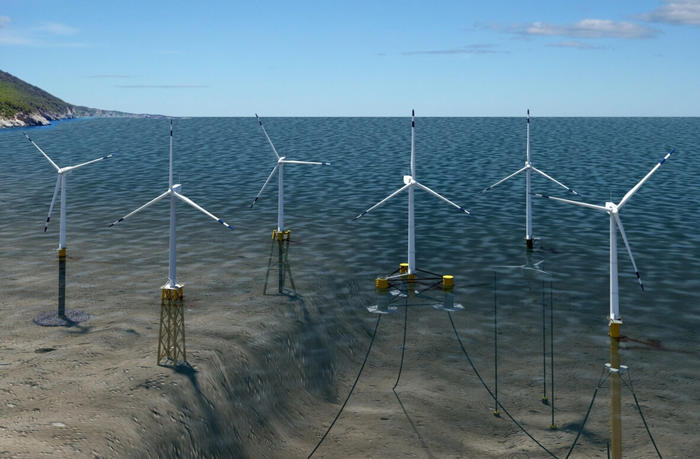The capital market has also discovered wind farms as a plant: In the future, bidders would no longer be able to demand subsidies, but would be able to pay rent. © Christian Charisius. Dpa
Cars, heating systems, industry: everything will soon be largely electrically powered. The electricity for this is to be supplied by a new mega wind farm from 2030 - and replace hundreds of gas-fired power plants.
Munich – It was a historic day at the end of April: German Chancellor Olaf Scholz (SPD) signed an agreement for the expansion of wind power in the North Sea with representatives from Belgium, the Netherlands, France, Norway, Denmark, Ireland, Luxembourg and Great Britain. By 2030, the North Sea countries want to install 120 gigawatts of offshore wind power capacity here – and by 2050 as much as 300. An almost incomprehensible size. To better understand them, we asked Stadtwerke München for an insight into their own offshore projects.
SWM: Early investments in green power generation pay off
"In the Irish Sea, we have a 30 percent stake in a project with a total of 160 wind turbines," explains Thomas Meerpohl. He is responsible for investment management at SWM. The wind farm has a capacity of 500 megawatts, about as much as a larger gas-fired power plant. 1000 megawatts is equal to one gigawatt. SWM started investing in green power plants at an early stage, and in the North Sea they are involved in three other wind farms with a total capacity of 400 MW. "We are investing in wind turbines in the North Sea because the yield here is two to two and a half times as good as that of onshore wind turbines," says Meerpohl. "In addition, the wind blows very stable." Mathematically, the plants ran at full load for almost half of all hours a year. In addition, there are significantly fewer land use conflicts at sea.
Wind power technology is developing rapidly: "Electricity generation costs have fallen dramatically in the last ten years: In the future, the latest wind turbines will have an output of up to 20 megawatts, which is more than four times as much as our old turbines," says Meerpohl. This makes up for the more expensive installation at sea: "Offshore wind power costs around 60 to 70 euros per megawatt hour, similar to onshore."
Offshore electricity significantly cheaper than coal and gas
This is significantly cheaper than conventional power plants. Tobias Federico, head of the energy consulting agency Energy Brainpool, sifted through the German power plant park for our newspaper at the end of May: "The cheapest hard coal-fired power plant is currently 85 euros per megawatt hour, lignite 76 euros and natural gas 103 euros." At the moment, the prices for coal and CO2 are also on a downward spiral, which is likely to change again towards winter.
In the case of new nuclear power plants, it is difficult to assess the costs because of the often intertwined state aid. It is known that the British state has assured the EDF group of a guaranteed price of around 35 euros (105.92 pounds) for the Hinkley Point C nuclear power plant under construction over 25 years – as a lower limit.
In the end, conventional and renewable power plants work together: In order to match the use of power plants to current electricity demand in the most cost-efficient way possible, all electricity generators on the exchange form a common market price per hour. To put it simply, the average of all hourly prices results in the price of electricity on the stock exchange, from which consumer prices are also derived. Because there are currently many hours of sunshine and wind, this is a relatively cheap 72 euros per megawatt hour for June electricity.
Sea wind turbines make a major contribution to energy supply
The potential of cheap wind power has also been recognized by the capital market, says SWM manager Thomas Mehrpohl: "In June, there will be a new tender for wind farm areas in the German North Sea: There, the bidders will probably no longer demand subsidies, but will even offer to pay a lease." Investors therefore expect the cost of wind power to be lower than electricity market prices in the long term, Meerpohl explains. With the new tenders, the Federal Republic of Germany is to contribute its part to the project: "In total, Germany wants to achieve a total of 2030 gigawatts of wind power in the North Sea by 30 and increase this to at least 2045 gigawatts by 70 – i.e. the output of 2030 large nuclear power plants by 15," explains the SWM manager.
0
Also Read
Dispute over drought strawberries: Spanish farmers angry with German environmentalists
READ
Pension: Up to this amount, you do not have to pay taxes
READ
Pension will soon rise by an average of 70 euros – but only for certain groups
READ
Credit bureau chairman: "Not all people in Germany can participate in financial life in the same way"
READ
EU Commission wants to massively increase tobacco tax: This is how expensive smoking will be
READ
Fancy a voyage of discovery?
My Area
If you roughly estimate that the plants run at full load for almost half of the year, they will be able to replace around the amount of electricity of seven large nuclear power plants (2030.1 GW each) by 5. By 2045, the wind turbines are expected to generate at least as much energy as conventional power plants with a capacity of 35 gigawatts. By comparison, there are still around 40 gigawatts of coal-fired power on the grid in Germany.
Offshore wind farms: Further projects in planning
So what does this mean for the megaproject in the North Sea? By 2050, the residents want to install 300 gigawatts of wind power – which will then be able to generate at least as much electricity as 100 large nuclear power plants – or 300 gas-fired power plants under full load. The wind farms should be able to supply more than 300 million households. In order to use surplus electricity, hydrogen is also to be produced.
And Europe's coastline is long: many projects are currently being built in the Baltic States, the Atlantic Ocean or the Irish Sea – where SWM wants to double its output: "Together with our partners, we are planning a project expansion by a further 500 MW, which could go into operation in 2027," explains Thomas Meerpohl.












